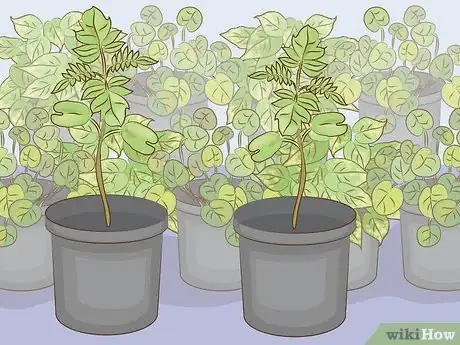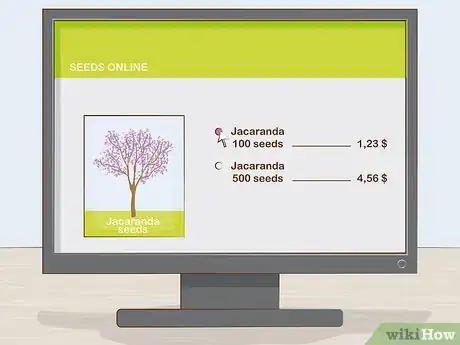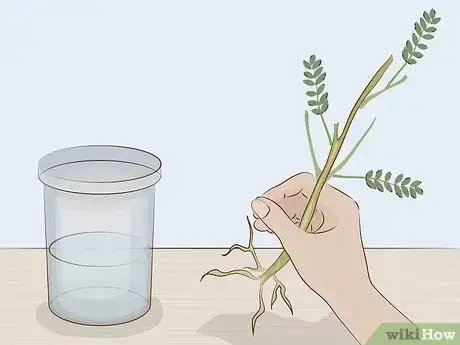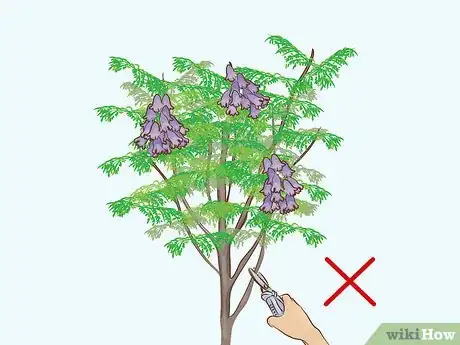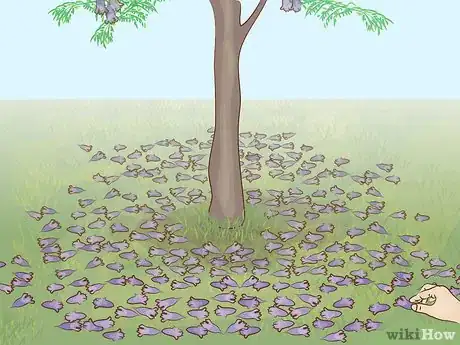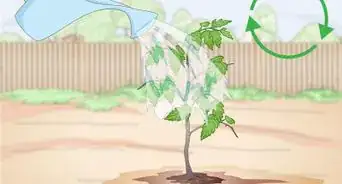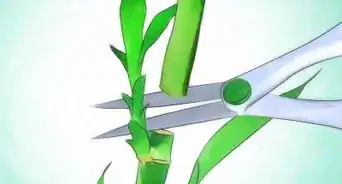This article was co-authored by Lauren Kurtz. Lauren Kurtz is a Naturalist and Horticultural Specialist. Lauren has worked for Aurora, Colorado managing the Water-Wise Garden at Aurora Municipal Center for the Water Conservation Department. She earned a BA in Environmental and Sustainability Studies from Western Michigan University in 2014.
wikiHow marks an article as reader-approved once it receives enough positive feedback. In this case, 91% of readers who voted found the article helpful, earning it our reader-approved status.
This article has been viewed 341,899 times.
The jacaranda—Jacaranda mimosifolia—is a large tree which is native to Brazil and which commonly grows throughout the southern United States, Australia, and in many other warm, humid climates. Jacarandas are perhaps best known for producing a beautiful display of bright purple or blue flowers in the spring.[1] To grow your own jacaranda tree, you’ll need to obtain a seedling and plant it in an outdoor setting which gives the tree plenty of room to grow.
Steps
Obtaining a Jacaranda Tree
-
1Purchase a jacaranda at a plant nursery. If you live in a temperate or warm climate, nearly all plant nurseries in your area should sell jacaranda seedlings.[2] If you need help locating a jacaranda plant, or if a nursery has different options to choose from, ask the sales staff for assistance.
- If there isn’t a plant nursery in your area, you can also visit the Garden section of large retail stores. Retailers like WalMart and Home Depot will stock a large variety of plants, and will likely carry jacaranda seedlings.
-
2Order a jacaranda seedling or seeds online. If you don’t live near a nursery or garden center, there may not be a way for you to purchase a jacaranda seedling in person. In this case, you can find and order a jacaranda online. Check major online plant retailers, such as Annie’s Annuals, Fast Growing Trees, or Nursery Live. Certain retailers will provide a seedling—with others, you may need to order a packet of seeds.Advertisement
-
3Plant a jacaranda from a cutting. If you know a friend or relative with a jacaranda tree, ask if you can take a cutting of their plant. A cutting is segment taken from a branch; the cutting itself should be at least 15 centimeters (6 inches) long, but can be as long as you would like. Place the jacaranda cutting in water until small roots begin to emerge.[5]
- Then, plant the cutting in a small pot filled with rich soil, water regularly, and let the tree grow.
-
4Transplant a growing jacaranda seedling. Jacaranda seedlings also tend to spring up around the base of mature jacaranda trees.[6] If you can safely and legally dig up one of these seedlings, you can transplant it into a planter and so begin growing your own tree.
Planting a Jacaranda
-
1Plant the jacaranda in a sunny area. Jacarandas thrive with sun, and should be planted in an area that will receive frequent, direct sunlight for most of the year.[7] Plant the tree at least 15-feet (4.5 meters) away from any nearby buildings, and do not plant seedlings in the shade of other, larger trees.
-
2Plant the tree in rich, well-drained soil. Jacaranda trees will suffer if their roots don’t drain well, and they need fertile, rich soil to provide them with nutrients.[8] If you’re planting your tree in a large planter or pot, place the jacaranda in a rich soil mixture. A local nursery or Garden center should have a variety of soil bags for sale, and sales staff can help you select a healthy mixture for your jacaranda.
- If you plant the tree directly into the ground, you’ll have less control over the makeup of the soil than if you were buying it from a plant nursery. Look for a patch of soil that isn’t prone to having puddles and has other plants already growing in it.
-
3Water the tree regularly in summer. Jacarandas need frequent watering in order to grow and thrive in temperate climates.[9] Healthy jacaranda trees grow quickly, but will wilt and possibly die if given insufficient water. Between March and October, use a household hose to water the jacaranda tree about once a week.
- During the cooler winter months, you do not need to water the tree as regularly. The jacaranda will not be growing during November through February, and so you should only water the tree about once a month.
-
4Plant the tree with plenty of surrounding space. Although they begin small as seedlings, jacarandas can grow into massive trees. Jacarandas commonly reach between 25-50 feet (7.6-15 meters) in height and can have a width of 15-30 feet (4.5-9 meters).[10] Plant the jacaranda in a large, open area where it will have room to grow to its full size. For example, jacarandas do well in large front or back yards.
- If you plant the jacaranda in an already cramped or crowded space (e.g. under a patio roof or between narrow walls) it will not grow to its full size and may wither and become unhealthy.
- Plant the tree at least 15-feet (4.5 meters) away from homes and other structures so that falling branches are less likely to cause damage.
Maintaining the Jacaranda
-
1Place mulch around the base of the tree. Jacarandas need to conserve much of the water that they’re given in order to thrive and grow. To help the tree conserve water, and to keep the water from evaporating directly from the soil, you can set mulch around the tree’s base. To achieve the best effect, lay the mulch about 5 centimeters (2 inches) thick.[11]
- Purchase mulch from a local landscaping company, plant nursery, or gardening center.
-
2Do not prune the tree. The branches of a jacaranda tree grow vertically and expand outward in all directions. Let the branches grow on their own; if you trim shoots or prune branches, you may permanently stunt the tree’s growth, or the tree may send up suckers. Whenever a jacaranda branch is pruned, it sends out vertical shoots, and so continual pruning will lead to an unnaturally tall and misshapen tree.[12]
- If left undisturbed, a jacaranda will grow into a roughly umbrella-shaped tree.
-
3Clean up the jacaranda’s dropped flowers. The tree’s bright-colored flower clusters can grow up to 12 inches (30 centimeters) long and 8 inches (20 inches) wide. When these fall from the tree, the flowers will carpet the ground, sidewalks, and roads beneath the tree. If the tree is on your property, you’ll be responsible for raking up and disposing of the jacaranda flowers.[13]
- Do not plant a jacaranda tree in a position where its branches will arch over a swimming pool. When the flowers fall in autumn, they will blanket the surface of the pool and can clog the water filter.[14]
Community Q&A
-
QuestionIs 16-16-16 a good fertilizer for a jacaranda tree? If its leaves turn yellow in the spring, is it due to too much or too little water?
 NinoxTop AnswererIf the leaves turn yellow in the spring, it is likely too much water. You can add sand to the dirt to avoid this problem. 16-16-16 can be used for jacaranda, but the best is organic fertilizer.
NinoxTop AnswererIf the leaves turn yellow in the spring, it is likely too much water. You can add sand to the dirt to avoid this problem. 16-16-16 can be used for jacaranda, but the best is organic fertilizer. -
QuestionHow long does it take a jacaranda tree to bloom?
 Community AnswerMine started blooming a few blooms during its 3rd or 4th year, but only a few blooms in the May/June time frame. But I bought mine from a nursery, and it might have been a grafted tree. If grown from seed, they will slower to bloom than one that has been grafted. Mine was grown in zone 9b, in full sun.
Community AnswerMine started blooming a few blooms during its 3rd or 4th year, but only a few blooms in the May/June time frame. But I bought mine from a nursery, and it might have been a grafted tree. If grown from seed, they will slower to bloom than one that has been grafted. Mine was grown in zone 9b, in full sun. -
QuestionCan jacaranda trees survive as potted plants?
 Community AnswerThese trees are routinely grown as desktop bonsai trees that bloom. With proper pruning and care, they will bloom in pots. Just make sure the container is large enough if you want to grow it normally (not bonsai).
Community AnswerThese trees are routinely grown as desktop bonsai trees that bloom. With proper pruning and care, they will bloom in pots. Just make sure the container is large enough if you want to grow it normally (not bonsai).
References
- ↑ http://www.burkesbackyard.com.au/fact-sheets/in-the-garden/flowering-plants-shrubs/jacarandas-trees/
- ↑ http://www.burkesbackyard.com.au/fact-sheets/in-the-garden/flowering-plants-shrubs/jacarandas-trees/
- ↑ http://www.burkesbackyard.com.au/fact-sheets/in-the-garden/flowering-plants-shrubs/jacarandas-trees/
- ↑ https://www.south-florida-plant-guide.com/jacaranda-tree.html
- ↑ http://www.mgsforum.org/smf/index.php?topic=1578.0
- ↑ http://www.burkesbackyard.com.au/fact-sheets/in-the-garden/flowering-plants-shrubs/jacarandas-trees/
- ↑ http://www.burkesbackyard.com.au/fact-sheets/in-the-garden/flowering-plants-shrubs/jacarandas-trees/
- ↑ http://www.burkesbackyard.com.au/fact-sheets/in-the-garden/flowering-plants-shrubs/jacarandas-trees/
- ↑ http://www.burkesbackyard.com.au/fact-sheets/in-the-garden/flowering-plants-shrubs/jacarandas-trees/
- ↑ https://www.fast-growing-trees.com/jacaranda-tree.htm
- ↑ http://www.burkesbackyard.com.au/fact-sheets/in-the-garden/flowering-plants-shrubs/jacarandas-trees/
- ↑ http://www.burkesbackyard.com.au/fact-sheets/in-the-garden/flowering-plants-shrubs/jacarandas-trees/
- ↑ http://www.south-florida-plant-guide.com/jacaranda-tree.html
- ↑ http://www.burkesbackyard.com.au/fact-sheets/in-the-garden/flowering-plants-shrubs/jacarandas-trees/
- ↑ http://www.burkesbackyard.com.au/fact-sheets/in-the-garden/flowering-plants-shrubs/jacarandas-trees/
- ↑ http://www.south-florida-plant-guide.com/jacaranda-tree.html
About This Article
To grow a jacaranda tree, you’ll need a seedling, soil mix, and a sunny spot with plenty of room to grow. You can usually find jacarandas at your local nursery. Alternatively, large retailers like Walmart or Home Depot often sell jacarandas. You'll also want to find a clear spot of land that is at least 15 feet away from other trees, since jacarandas grow quite tall. After planting your jacaranda, surround it with some rich soil mixture to help it grow. Then, water it about once a week in the summer months and once a month in the winter months. To learn how to maintain your new jacaranda tree, read more from our Gardening co-author!
